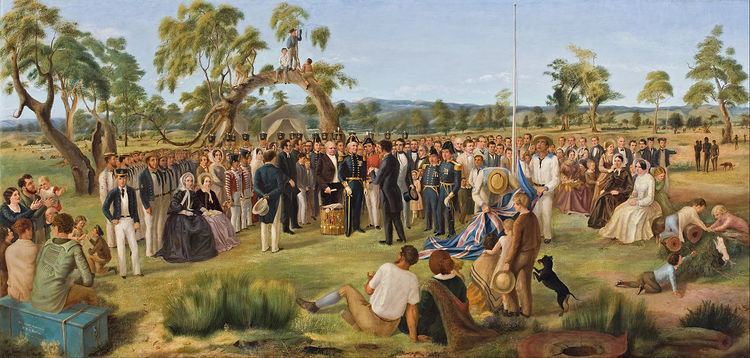 | ||
Proclamation Day is the name of official or unofficial holidays or other anniversaries which commemorate or mark an important proclamation. In some cases it may be the day of, or the anniversary of, the proclamation of a monarch's accession to the throne. A proclamation day may also celebrate the independence of a country, the end of a war, or the ratification of an important treaty.
Contents
South Australia
Proclamation Day in South Australia celebrates the establishment of government in South Australia as a British province. The proclamation was made by Captain John Hindmarsh beside The Old Gum Tree at the present-day suburb of Glenelg North on 28 December 1836. The proclamation specified the same protection under the law for the local native population as for the settlers. The date 28 December as a public holiday in South Australia was modified to the first otherwise working day after the Christmas Day public holiday (i.e. usually 26 December). Formal ceremonies involving the most senior current officials and politicians, followed by public celebrations, continue to be held at the still-extant Old Gum Tree at Glenelg on 28 December.
The proclamation was printed by Robert Thomas (1782–1860), who came from England with his family on the Africaine, arriving at Holdfast Bay on 8 November 1836. Thomas brought with him the first printing press to reach South Australia. The press was a Stanhope Invenit No. 200, and was on display in the State Library until 2001. It may be surmised that, from the quilled text of the proclamation provided to him by the officials, it was Thomas himself who made a more striking layout for print, later most familiar to the public.
The colonising fleet consisted of 10 vessels which had gathered at Nepean Bay before being directed to Holdfast Bay. The Africaine was the first to arrive, discharging settlers on 9 November 1836, followed by the Emma, the John Pirie, and the Tam O'Shanter. These deliberately preceded Governor John Hindmarsh on the Buffalo to enable preparations including the printing of the proclamation in advance of his formal arrival on 28 December. Thomas's wife Mary (1787–1875) published The Diary of Mary Thomas, in which she described the journey on the Africaine and the early years in South Australia. An extract from the diary reads:
"About December 20th 1836, we built a rush hut a short distance from our tents for the better accommodation of part of our family... and in this place (about 12 feet square) the first printing in South Australia was produced."
One of the children of Robert and Mary Thomas was a surveyor who assisted Colonel William Light in the survey which led to the founding of the City of Adelaide. Another son, William Kyffin Thomas, inherited from his father the newspaper of the time, The Register, which his parents had set up. William had a son, also called Robert, who became senior proprietor of The Register. He was knighted by King Edward VII in 1909 when President of the first great Press Conference in London. A majestic statue of that king stands prominently outside the South Australian Institute building in North Terrace, Adelaide.
Western Australia
Proclamation Day also refers to October 21, 1836, the day that responsible government was proclaimed in Western Australia. It used to be a public holiday in Western Australia, but gradually the celebrations were pre-empted by those who wished to celebrate the achievement of the eight-hour day. In 1919 it was renamed Labour Day, and shortly afterwards the celebration date changed, with the result that Proclamation Day is no longer a public holiday in Western Australia.
